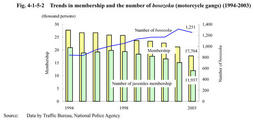| Previous Next Index Image Index Year Selection | |
|
|
1. Delinquency in groups Fig. 4-1-5-1 shows the percent distribution of cleared non-traffic penal code offenses committed by juveniles in2003by the number of perpetrators and by type of offense.The percentage of accomplice cases(cases involving two or more juveniles)was highest for robbery(68.3%),followed by extortion(61.4%)and injury(39.7%).Those percentages are far above those for adults(22.1%for robbery,41.3%for extortion,and11.0%for injury).
Fig. 4-1-5-1 Percent distribution of non-traffic penal code offenses committed by juveniles by type of offense and number of perpetrators(2003) A typical type of juvenile delinquent group is motorcycle gangs,known as bosozoku. Fig. 4-1-5-2 shows the trend in membership and number of bosozoku groups in the last10years.Membership has decreased consistently,standing at17,704persons,down16.4%from the previous year,in2003.While the number of bosozoku had been on the rise since1996,it has decreased to1,251,down4.7%from the previous year,in2003.With respect to the size of bosozoku,the percentage of those gangs with30or more members fell from9.2%in1994to2.4%in2003,indicating that groups are becoming smaller in scale(Source:Data by Traffic Bureau,National Police Agency).Fig. 4-1-5-2 Trends in membership and the number of bosozoku(motorcycle gangs)(1994-2003) |

